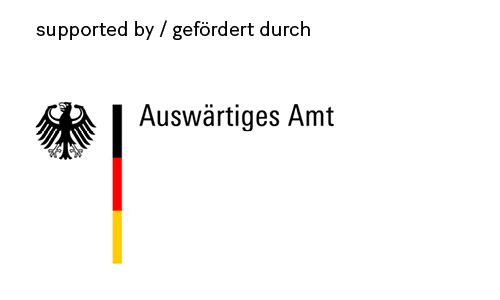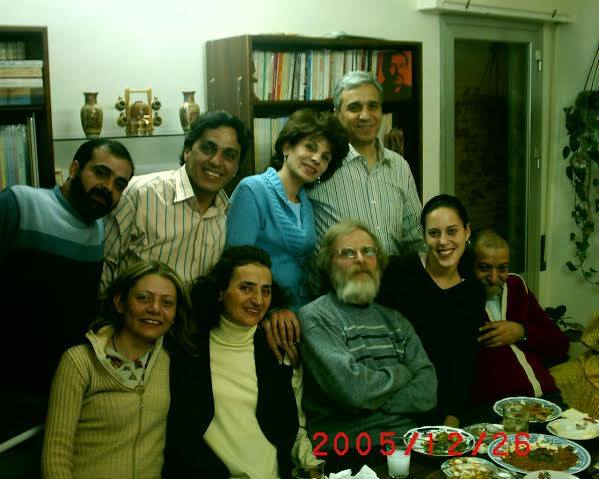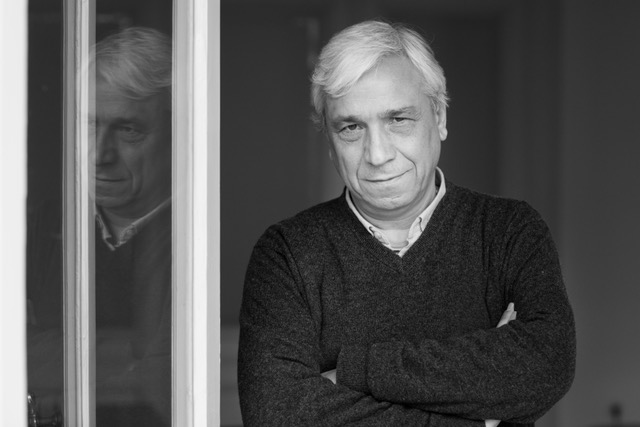صورة من سوريا وسيرة سورية
التقطت هذه الصورة في بيتنا، زوجتي سميرة الخليل وأنا (سميرة تسند رأسها على كتفي في الخلف)، في ضاحية غرب دمشق قبيل نهاية 2005. في الصورة كثير من تاريخ سوريا خلال نصف القرن المنقضي، دون أن يكون تاريخ أناس ذوي سلطة أو مال أو نفوذ.
تجلس إلى اليسار في الصورة رزان زيتونة، المحامية وناشطة حقوق الإنسان والكاتبة، وواحدة من أبرز رموز الثورة السورية التي قد يصح القول إن جانبا أساسيا منها قد غاب بغيابها. رزان أبرز مؤسسي لجان التنسيق المحلية، ذات الدور المهم في تنظيم أنشطة احتجاجية وتغطيتها إعلاميا وتوثيق أحداثها. وهي عاشت فوق عامين متوارية في دمشق قبل أن تتدبر أمر تهريبها مع وائل حمادة، زوجها، إلى دوما يوم 25 نيسان 2013. في دوما والغوطة عملت رزان على توثيق الانتهاكات الواقعة على الشعب السوري من قبل المنتهك الأكبر، النظام، ثم بالتدريج من قبل منتهكين طامحين، إسلاميين. رزان اختطفها تشكيل سلفي مسلح اسمه جيش الإسلام في دوما قبل منتصف ليلة 9 ديسمبر 2013.
تجلس قرب رزان رندة بعث، وهي مترجمة للعديد من الكتب من الفرنسية إلى العربية.
إلى جانب رندة زوجها عماد شيحة الذي قضى 30 عاما في سجون النظام، بين 1974 و2004. عماد كان عضوا في تنظيم شيوعي عربي، كان له أعضاء في ثلاثة بلدان:
الكويت ولبنان وسورية. اعتقل جميع أعضاء التنظيم، وكانوا بالعشرات، وكان أسوأ ما عاناه الكويتيون واللبنانيون منهم ثلاث سنوات في السجن. كانت المنظمة الشيوعية العربية قد قامت بتفجير في دمشق ضد إحدى المصالح الأميركية عام1974، تسبب في مقتل مواطن سوري. في مقابلة أجرتها معه رزان زيتونة بعد أسابيع من سنواته الثلاثين في السجن، يلخص عماد مصير المنظمة كالتالي: „تلقى خمسة من الرفاق حكما بالإعدام، نفذ في 2 آب 1974. ثمانية أعضاء حكموا بالسجن 15 عاما وخمسة حكموا بالسجن المؤبد“. مما لم يقله عماد أن أخاه غياث كان أحد الذين أعدموا، وأنه هو وفارس مراد (أقصى يمين الصورة جلوسا) كانا ممن حكموا بالسجن المؤبد.
في السلطة إثر انقلاب عسكري منذ أقل من أربع سنوات وقتها، ربما وجد حافظ الأسد في حدث كهذا فرصة لفرض احتكار العنف والشرعية والعدالة معا. صار الرجل بعد قليل معيار شرعية نظامه، بل الدولة السوري، وكيان سورية ذاتها، وهو ما أسس لانقلاب الجمهورية إلى حكم وراثي. حافظ الأسد غائب في هذه الصورة، وكان غائبا عن الحياة وقت التقاطها، بعد أن كان الصورة كلها طوال ثلاثين عاما من الحكم. الصورة هي لسورية الأخرى، غير المرئية للعموم وقتها.
بعد ثلاثين عاما من السجن ترجم عماد كتبا من الإنكليزية إلى العربية وألف روايتين: موت مشتهى، وبقايا من زمن بابل. وهو يعيش مع رندة في دمشق.
قرب عماد صبية سورية تعيش خارج البلد لكنها كانت في زيارة لسورية وقتها، صديقة لرزان، لها اسم فاعل في الكتابة عن سورية والنشاط في القضية السورية.
قرب الصبية فارس مراد، فلسطيني سوري من مواليد مخيم النيرب في حلب، صديق عماد وشريكه في المنظمة والقضية والسجن. فارس أفرج عنه في شباط 2004، قبل عماد بنحو ستة شهور. تطور لديه في سنوات السجن الطويلة مرض التهاب الفقار اللاصق (سبونديلوزيس). تلتصق فقرات العمود الفقري ببعضها، فينحني الظهر وتنضغط الرقبة، فيحتاج فارس إلى مناورة خاصة كي ينظر إلى محدثه. تنضغط الرئتين كذلك بين العمود الفقري المنحني والمتصلب وبين الأضلاع، ما يتسبب في ضيق التنفس والتهابات تنفسية. هذ ما أودى أخيرا بحياة فارس الذي كان ممنوعا من المغادرة وتلقي العلاج خارج البلد. رحل فارس وهو في التاسعة والخمسين عام 2009، ودفن في دمشق. الملتحي على الشمال وقوفا هو شادي كردية، وهو صديق لنا، سميرة وأنا، ولد في مدينة السلمية وسط سورية وكان يعيش فيها. وقتها كان في زيارة لنا. لم يكن شادي معتقلا سياسيا سابقا، ولا ناشطا سياسيا بصورة خاصة. لكنه كان ينتمي لمجتمع المعتقلين السياسيين اليساريين السابقين في سورية من باب الثقة والصداقة. اعتقل شادي لمرتين بعد الثورة السورية، وتعرض للتعذيب. وتوفي بعد وقت قصير من خروجه من الاعتقال الثاني. كان في الثالثة والأربعين وقت رحيله.
يقف إلى جانب شادي ناظم حمادي، وهو محام وشاعر وناشط في مجال حقوق الإنسان. ناظم أحد مؤسسي لجان التنسيق المحلية إلى جانب رزان. وقد عاش متواريا هو الآخر منذ بداية الثورة حتى تهريبه (مع وائل حمادة) إلى دوما في أيلول2013، بعد أسابيع من المذبحة الكيماوية في الغوطة الشرقية. ناظم لم يكد يكمل ثلاثة شهور في دوما قبل أن يختطفه جيش الإسلام ويغيبه مع رزان. بعد غيابه صدر لناظم عمل شعري بعنوان ضد. قبل الغياب لنظام كتاب شعري آخر بعنوان: أوراق التوت الغامضة.
قرب ناظم تقف سميرة الخليل، زوجة كاتب هذه السطور. سميرة كانت ناشطة ضمن تنظيم يساري معارض للنظام اسمه حزب العمل الشيوعي، وقضت فوق أربع سنوات معتقلة بين 1987 و1991، مع أكثر رفيقاتها ورفاقها. سميرة مغيبة مع ناظم ورزان ومجهولة المصير منذ ليلة 9 ديسمبر 2013. بعد تغييبها نشر لسميرة كتاب بتضمن يوميات دونتها بخط اليد عن أوضاع الحياة في دوما المحاصرة والمعرضة للقصف من قبل النظام. يتضمن الكتاب كذلك بعض ما أمكن الحصول عليه من بوستات نشرتها سميرة على صفحتها على فيسبوك، وقد أغلقت دون أن يمكن استرجاعها بعيد خطفها. يوميات الحصار في دوما 2013، وهذا عنوان الكتاب، ترجم إلى الإسبانية والإيطالية والفرنسية، والترجمة الانكليزية ناجزة، لكنها لم تنشر بعد.
إلى جانب سميرة أقف أنا، زوجها، وقد كنت كذلك معتقلا سياسيا يساريا لنحو 16 عاما، بين 1980 و1996، لانتمائي إلى تنظيم شيوعي معارض آخر اسمه الحزب الشيوعي
السوري- المكتب السياسي. بعد السجن تعرفت على سميرة، واقترنت علاقتا ثم زواجنا ببدايات عملي ككاتب. لي تسع كتب منشورة، ومئات المقالات في صحف ومجلات. أعيش خارج سورية منذ أكتوبر 2013، في تركيا أولا، ثم منذ خريف 2017 في ألمانيا.
وراء الكاميرا يقف وائل حمادة، زوج رزان. وهو كذلك ناشط حقوقي وسياسي معارض للنظام، ومن مؤسسي لجان التنسيق المحلية. وائل اعتقل مرتين عند النظام، والمرة الأخيرة في مطار المزة التي كانت تسيطر عليه الفرقة الرابعة، التشكيل العسكري الفاشي الذي يقوده ماهر الأسد، شقيق بشار، وحولت بعض هنغارات الطائرات فيها إلى معسكر تعذيب. كان وائل قصد دوما تهريبا أول مرة مع رزان يوم 25 نيسان 2013، لكن الرجل الشجاع عاد إلى دمشق، مستأنفا نشاطه الثوري، قبل أن يرجع من جديد إلى دوما ويستقر فيها في أيلول 2013. وائل غيب مع رزان نظام وسميرة منذ مساء 9 ديسمبر 2013.
فارس وشادي رحلا قبل الأوان. رزان وناظم وسميرة ومصورنا وائل مغيبون منذ أكثر من ثماني سنوات. عماد ورندة عاشا طوال الوقت في دمشق، وهما منذ أسابيع فقط في باريس لدواع صحية. المرأة الشابة التي عاشت معظم عمرها خارج سورية تستمر في العمل خارج سورية بصور مختلفة.
هناك تفصيلان بالغا الأهمية في الصورة فوق. أولهما صورة بالأحمر والأسود إلى اليمين من رأسي لسمير قصير. سمير صحفي ومؤرخ وناشط لبناني، اغتيل في بيروت في حزيران 2005، بعيد الانسحاب القسري لقوات النظام الأسدي من بيروت في نيسان، 2005، وكان الخامسة والأربعين من العمر. كان لسمير دور ميداني مهم في الانتفاضة اللبنانية التالية لهذا الانسحاب، وهو اغتيل بعبوة ناسفة وضعت تحت سيارته بسبب هذا الدور على الأرجح. اغتيال سمير كان رد فعل النظام الأمني السوري اللبناني على الانسحاب، ومعلوم أنه اندرج في سلسلة اغتيالات بدأت باغتيال رفيق الحريري، رئيس الوزراء اللبناني الأسبق في شباط من العام نفسه. سمير هو أول مثقف لبناني، مع جذور عائلية فلسطينية وسورية، يربط بين استقلال لبنان وديمقراطية سورية. له كتاب بهذا العنوان. قبل نحو عام من اغتياله، كنا، سميرة وأنا في بيروت، التقينا بسمير، الذي وقع لي كتابه: ديمقراطية سورية واستقلال لبنان، وكتابه الآخر: عسكر على مين؟ بعد هذه الرحلة إلى بيروت، منعت من السفر، فلم أستطع أن أشارك في وداعه.
في بقايا آوشفيتز يتكلم جيورجيو أغامبن، وفي باله معسكرات الاعتقال النازية، على مفارقة الشاهد: من رأى كل شيء لا يشهد لأنه لم ينج، ومن نجا لم ير كل شيء وشهادته ناقصة. الشهادة بالتالي غير ممكنة، وليس ثمة شهود على أحوج ما يكون إلى شهود:
أقاصي المصير البشري من اعتقال وتعذيب واغتيال وغياب. من يا ترى رأى كل شيء؟ سمير؟ فارس؟ شادي؟ سميرة ورزان ووائل وناظم؟ لم يعد أحد منهم ليشهد.
في العربية علاقة اشتقاقية بين الشهيد والشاهد، يمكن أن نبني عليها أن الواحد منا لا يكون شاهدا إلا إن كان شهيدا، لأن الشهيد هو الذي شهد كل شيء. لكن الشهداء لا يعودون من الموت كي يرووا لنا. من يروون هم نحن الذي لم نستشهد كي نشهد. لكننا نشهد. نشهد لأننا لم ننج ونجونا في آن. نجاتنا مما جرى لأحبابنا وأصدقائنا فرصة للكلام، وعدم نجاتنا يرجح عدالة شهادتنا.
التفصيل الآخر هو الكتب في خلفية الصورة. هذه مكتبتنا، سميرة وأنا، في بيتا المستأجر في ضاحية قدسيا. الكتب هذه أودعت في صناديق كرتون، أودعت بدورها في قبو ما في دمشق. كانت سميرة قد غيبت قبل أسابيع قليلة وقت إخلاء البيت، وقد تكفل به بعض أحبابنا، وكنت سلفا خارج سورية وقتها.
في الصورة فوق 24 عاما من التغييب، فوق 80 عاما من السجن، قتل اغتيالا، موتان مبكران، سنوات من حياة اللجوء المعلقة. تشكل هذه التجارب هوية سورية وغير قليل من
هوية لبنان خلال نحو خمسين عاما. البلدان اليوم في أقسى أزمتين في تاريخ كل منهما خلال أكثر من قرن.
ياسين الحاج صالح
Ein Foto aus Syrien – eine syrische Geschichte
Dieses Foto wurde in der Wohnung von meiner Frau Samira al-Khalil und mir aufgenommen (Samira, hinten, legt ihren Kopf auf meine Schulter), in einem westlichen Vorort von Damaskus Ende 2005. Es spiegelt viel von der Geschichte Syriens im letzten halben Jahrhundert wider, wenn auch nicht die Geschichte von Leuten mit Macht, Geld und Einfluss.
Links vorne sitzt Razan Zeitouna, Rechtsanwältin, Menschenrechtsaktivistin und Autorin. Razan war eine der herausragendsten Symbolfiguren der syrischen Revolution und man kann sagen, dass mit ihrem Verschwinden ein grundlegender Bestandteil unseres Aufstandes verlorenging. Razan war eine der maßgeblichen Begründerinnen der lokalen Koordinationsräte, die eine wichtige Rolle für die Organisation von Protestaktionen, der Berichterstattung darüber und ihre Dokumentation spielten. Mehr als zwei Jahre lang lebte sie versteckt in Damaskus, bis sie sich am 25. April 2013 zusammen mit ihrem Mann Wail Hamade in den Vorort Duma schleusen lassen konnte. In Duma und in der Ghouta dokumentierte Razan die Menschenrechtsverletzungen gegen die syrische Zivilbevölkerung, die überwiegend vom Assad-Regime ausgingen, nach und nach aber auch von immer ambitionierter auftretenden Islamisten.
Eine bewaffnete salafistische Gruppe namens Armee des Islam entführte Razan in Duma gegen Mitternacht am 9. Dezember 2013.
Neben Razan sitzt Randa Baath, die viele Bücher aus dem Französischen ins Arabische übersetzt hat, daneben ihr Mann Imad Shiha, der fast dreißig Jahre in Regimegefängnissen saß, von 1975 bis 2004! Er gehörte einer kommunistischen Organisation an, die in Kuwait, Libanon und Syrien aktiv war. Sämtliche ihrer Mitglieder, mehrere Dutzend, kamen in Haft und bekamen in Kuwait und Libanon maximal drei Jahre Haft. Die Organisation hatte 1974 in Damaskus einen Sprengstoffanschlag gegen eine amerikanische Einrichtung begangen, bei der ein Syrer ums Leben kam. In einem Interview, das Razan Zeitouna einige Wochen nach seiner Entlassung aus seiner dreißig Jahre dauernden Haft mit ihm führte, sagte Imad: „Fünf meiner Genossen wurden in Syrien zum Tode verurteilt und am 2. August 1975 hingerichtet. Acht Mitglieder bekamen fünfzehn Jahre Gefängnis, und fünf lebenslänglich.“ Was Imad nicht sagte, war, dass sein Bruder Ghiath einer der Hingerichteten war, und dass er und Faris Murad (ganz rechts sitzend) zu lebenslänglicher Haft verurteilt worden waren.
Hafiz al-Assad sah in dieser Sache damals wohl eine Gelegenheit, Gewaltmonopol, Legitimität und Gerichtsbarkeit zugleich durchzusetzen. Schon bald danach wurde er zum Maßstab der Legitimität seines Regimes, ja des syrischen Staates und des Landes schlechthin, womit der Grundstein für eine Erbherrschaft gelegt war. Hafiz al-Assad fehlt auf dem Foto, er lebte zum Zeitpunkt der Aufnahme nicht einmal mehr, aber dreißig Jahre lang hatte er das Bild von Syrien komplett ausgefüllt.
Nach dreißig Jahren im Gefängnis übersetzte Imad noch Bücher aus dem Englischen ins Arabische und schrieb drei Romane: „Blütenpollen“, „Ein ersehnter Tod“ und „Was von Babylon blieb“. Er lebte mit Randa noch bis vor kurzem in Damaskus.
Rechts von Imad sitzt eine junge Syrerin, die im Ausland lebt und damalszu Besuch in Syrien war. Sie ist eine Freundin von Razan und als Autorin von engagierten Texten zu Syrien bekannt.
Neben ihr ist Faris Murad zu sehen, syrischer Palästinenser aus dem Flüchtlingscamp Neirab bei Aleppo, ein Freund und Genosse von Imad, der dessen Anschauungen teilte und mit ihm in der Organisation und in Haft war. Faris wurde im April 2004 entlassen, etwa sechs Monate vor Imad. Während der Haft hatte er sich eine Wirbelsäulenentzündung (Spondylitis) zugezogen, die zu einer Verklebung der Wirbel, einer Rückenkrümmung und einer Halseinengung führt; Faris musste sich daher verrenken, um nach vorn zu sehen. Zudem klemmt die Krankheit die Lunge zwischen der versteiften Wirbelsäule und den Rippen ein, was zu Atemnot und Atemwegsentzündungen führt. 2009 verstarb Faris daran, weil er Syrien nicht verlassen durfte, um sich im Ausland behandeln zu lassen. Er wurde 59 Jahre alt und ist in Damaskus begraben.
Der Bärtige links hinten ist Shadi Kurdiye, ein Freund von Samira und mir. Er stammt aus Salamiye in Mittelsyrien, wo er auch lebte. Zum Zeitpunkt der Aufnahme war er bei uns zu Besuch. Shadi war kein wirklicher Aktivist und nicht in politischer Haft gewesen, aber er war aus Freundschaft der damaligen Gesellschaft linker politischer Gefangener in Syrien beigetreten. Nach der Revolution wurde er zweimal verhaftet und gefoltert. Kurz nach seiner Entlassung aus der zweiten Haft starb er mit 43 Jahren.
Neben Shadi steht Nazim Hamadi, Rechtsanwalt, Dichter und Menschenrechtsaktivist sowie Mitbegründer der genannten Koordinationsräte. Auch er lebte zu Beginn der Revolution versteckt in Damaskus, bis er sich im September 2013, wenige Wochen nach dem Giftgasmassaker in der östlichen Ghouta, mit Wail Hamade nach Duma schleusen lassen konnte. Kaum drei Monate später verschleppte ihn dort die Armee des Islam zusammen mit Razan. Nach seinem Verschwinden erschien ein Gedichtband von ihm unter dem Titel „Dagegen“. Aus der Zeit vorher stammt seine Gedichtsammlung „Bizarre Feigenblätter“.
Neben Nazim steht meine Frau Samira al-Khalil. Samira war in der oppositionellen Kommunistischen Arbeitspartei aktiv und verbrachte mit den meisten anderen ihrer Genossinnen und Genossen die Jahre von 1987 bis 1991 als linke politische Gefangene in Haft. Samira wurde in der Nacht des 9. Dezember 2013 zusammen mit Razan verschleppt, seither ist auch ihr Schicksal ungeklärt. Nach ihrem erzwungenen Verschwinden erschienen ihre ursprünglich handschriftlichen Aufzeichnungen als Buch; sie handeln vom Leben unter Belagerung und Beschuss des Regimes in Duma. Das Buch dokumentiert auch einige Facebook-Posts von Samira, soweit sie noch rekonstruierbar waren; ihr Account verschwand nach ihrer Entführung. Das Buch trägt den Titel „Tagebuch der Belagerung in Duma 2013“ und wurde ins Spanische, Italienische und Französische übersetzt. Die englische Übersetzung liegt vor, ist aber noch unveröffentlicht.
Neben Samira stehe ich. Ich war selbst fast 16 Jahre lang linker politischer Gefangener, von 1980 bis 1996, weil ich der oppositionellen Syrischen Kommunistischen Partei – Politbüro angehörte. Nach meiner Freilassung lernte ich Samira kennen, und wir begannen eine Beziehung und heirateten, als ich mit dem Schreiben begann. Ich habe neun Bücher veröffentlicht und hunderte von Aufsätzen für Zeitungen und Zeitschriften geschrieben. Ich habe Syrien im Oktober 2013 verlassen, zunächst in die Türkei, und lebe seit Herbst 2017 in Deutschland.
Hinter der Kamera stand Wail Hamade, Razans Mann. Auch er war Menschenrechtsaktivist und Regimegegner und Mitbegründer der lokalen Koordinationsräte. Er wurde zweimal vom Regime verhaftet, das zweite Mal am Flughafen Mazze, der von der Vierten Brigade kontrolliert wurde, eine faschistische Militäreinheit unter Führung des Präsidentenbruders Maher al-Assad. Einige Hangars waren zu Haftlagern umgebaut worden, in denen Wail schwer gefoltert wurde. Wail war zuerst am 25. April 2013 heimlich mit Razan nach Duma gekommen, ging aber dann in einer mutigen Mission nach Damaskus zurück, um von dort weiter für die Revolution zu arbeiten, bevor er im September 2013 erneut nach Duma kam. Am Abend des 9. Dezember 2013 wurde er dort zusammen mit Razan, Nazim und Samira verschleppt.
Faris und Shadi sind zu früh verstorben. Razan, Nazim und Samira sowie unser Fotograf Wail sind seit über acht Jahren verschleppt. Imad und Randa lebten ununterbrochen in Damaskus und sind erst seit wenigen Wochen zur medizinischen Behandlung in Paris. Die junge Frau, die die meiste Zeit ihres Lebens außerhalb Syriens gelebt hat, setzt vom Ausland aus in verschiedener Weise ihre Arbeit für Syrien fort.
Zwei weitere wichtige Details stecken in dem Foto. Das eine ist das Bild in Rot und Schwarz rechts von meinem Kopf; es zeigt Samir Kassir. Samir war ein libanesischer Journalist, Historiker und Aktivist. Im Juni 2005 wurde er in Beirut kurz nach dem erzwungenen Abzug der Assad-Armee aus dem Libanon mit 45 Jahren ermordet. Samir spielte eine wichtige Rolle im vorhergehenden libanesischen „Aufstand für die Unabhängigkeit“ und wurde durch einen Sprengsatz unter seinem Auto getötet, wahrscheinlich wegen seiner Aktivität. Die Ermordung von Samir Kassir war die Reaktion des syrisch-libanesischen Sicherheitsapparats auf den Abzug und reihte sich ein in eine ganze Serie von Attentaten, angefangen bei Rafik al-Hariri, dem libanesischen Ministerpräsidenten, im Februar desselben Jahres. Samir war der erste libanesische Intellektuelle (mit palästinensischen und syrischen Wurzeln), der eine Verbindung zwischen libanesischer Unabhängigkeit und Demokratie in Syrien herstellte. Ein Jahr vor seiner Ermordung waren Samira und ich in Beirut und trafen ihn, und er signierte mir sein Buch „Die Demokratie Syriens und die Unabhängigkeit des Libanon“. Ein anderer Titel von ihm lautete: „Armee gegen wen?“ Nach jener Reise durfte ich Syrien nicht mehr verlassen und konnte ihm nicht das letzte Geleit geben.
Giorgio Agamben schreibt in „Was von Auschwitz bleibt“ beim Gedanken an die NS-Vernichtungslager über das Paradoxon des Zeugen in etwa: Wer alles gesehen hat, kann kein Zeugnis ablegen, weil er nicht überlebt hat, wer überlebt hat, hat nicht alles gesehen und kann daher nur unvollständig Zeugnis ablegen. Ein umfassendes Zeugnis ist daher unmöglich, und es gibt keine Zeugen für das, wofür man dringend Zeugen bräuchte: die menschlichen Extremerfahrungen von Haft, Folter, Mord und erzwungenem Verschwinden. Wer hat „alles“ gesehen? Samir? Shadi? Samira, Razan, Wail und Nazim? Keiner von ihnen ist mehr da, um zu berichten.
Im Arabischen gibt es eine direkte Wortverwandtschaft zwischen shahīd (Märtyrer) und shāhid (Zeuge). Daraus lässt sich der Satz bilden, man könne nur Zeuge sein, wenn man den Märtyrertod gestorben ist, denn nur der Märtyrer hat „alles“ gesehen. Aber die Toten kehren nicht zurück, um uns zu berichten. Berichten können nur wir, die nicht gestorben sind und entsprechend kein volles Zeugnis ablegen können. Und doch tun wir es, weil wir gleichzeitig nicht überlebt und überlebt haben. Dass wir das überlebt haben, was von uns geliebten Menschen passiert ist, gibt uns Gelegenheit zu sprechen, und dass auch wir nicht heil davongekommen sind, gibt unserem Zeugnis Gewicht.
Das andere Detail sind die Bücher hinter uns in unserer Mietwohnung im Vorort Qudsaya. Sie waren aus dem Bestand von Samira und mir und wurden später in Kartons gepackt und in irgendeinen Keller in Damaskus gebracht. Samira wurde wenige Wochen vor der Aufgabe der Wohnung verschleppt. Freunde übernahmen die Räumung unserer Wohnung. Ich selbst hatte Syrien damals bereits verlassen.
Das Foto steht für über 24 Jahre erzwungenen Verschwindens, für über 80 Jahre Haft, für Mord, für zwei zu früh Verstorbene und für Jahre unsteten Lebens auf der Flucht. Darin spiegelt sich die Realität Syriens und zum Teil des Libanon über einen Zeitraum von fast 50 Jahren. Beide Länder befinden sich heute in der schlimmsten Krise ihrer Geschichte seit über einem Jahrhundert.
Übersetzung: Günther Orth
Syrian bios in a photo: who is the witness?
This photograph was taken in our house, my wife Samira Al-Khalil and me (Samira leans her head on my shoulders at the back), in the Qudsayya suburb to the west of Damascus towards the end of 2005. The photograph encompasses a lot of Syria’s history in the last half century, without being a photo of people invested with power, capital or influence.
Seated on the left in the photograph is the lawyer, human rights activist, and author Razan Zaytounawho is one of the most prominent figures of the Syrian revolution, a revolution that is now missing an essential component with her absence. Razan was one of the most prominent founders of the Local Coordinating Committees (LCC) that was instrumental organizing protests as well as documenting and covering them in the press. She lived in hiding for over two years in Damascus before she was smuggled out with Wael Hamada, her husband, to Douma on the 25th of April 2013. Razan worked in Douma and Eastern Ghouta documenting atrocities committed against the Syrian people at the hands of the main violator, the regime, and then the then ascending violators, Islamists. On the evening of the 9th of December 2013, Razan was abducted by an armed Salafist militia called The Army of Islam.
Seated near Razan is Randa Baath, who has translated several books from French to Arabic by the likes of Pierre Bourdieu, Olivier Roi, Pascal Dibie and many others.
At Randa’s side is her husband Emad Shiha, who has spent 30 years in the regime’s prisons between 1974 and 2004. Emad was a member of a pan Arab Communist Organization (ACO) which spanned three countries: Kuwait, Lebanon, and Syria. All the members of the organization, hardly a few dozens, were arrested, with the worst thing the Kuwaitis and Lebanese suffered from being a three-year prison sentence. The ACO had carried out a bombing of an American facility in Damascus in 1974, which resulted in the death of a Syrian citizen. In an interview conducted by Razan Zaytouna weeks after his thirty-year in jail, Emad summarized the organization’s fate as follows: “five of our comrades received death sentences which were carried out on the 2nd of August 1975. Eight members received 15-year sentences, and five got life sentences”. What Emad did not mention was that his brother, Ghiyath, was one of those executed, while he and Fares Mourad (seated on the far right of the picture) were two of the people who received life sentences.
At the time of the executions, it had been just under five years since his military coup d’état, and perhaps Hafez al-Assad saw this as an opportunity to monopolize violence, legitimacy, and justice all in one move. The man would become soon the source of his regime’s legitimacy, of the Syrian state, and its very entity indeed. This is what lay the grounds for transforming the republic in Syria to a dynastic rule. Hafez al-Assad is absent in this photograph, and he was absent from life when it was taken, after thirty years in power where his image was omnipresent. The photograph shows another Syria, divers and multicolored, one that was invisible at that time.
After thirty years in prison, Emad began translating books from English into Arabic, he also wrote two novels: The pollen, Desired Death and Remnants of Babylonian Times. Up to recently, he was residing in Damascus with Randa. They have just moved to Paris for medical reasons.
Near Emad sits a young Syrian woman who lived abroad but was visiting Syria at the time, she was a friend of Razan as well as being a prominent writer and activist for the Syrian cause. It is a very Syrian thing not to be able to mention her name.
Near the young woman is Fares Murad, a Palestinian-Syrian who was born in Al-Nayrab refugee camp in Aleppo. He is a friend of Emad and his comrade in the ACO, in struggle, and in prison. Fares was released in February 2004, six months before Emad. During his time in prison, he developed spondylosis where the vertebrae begin to fuse together, causing a curvature in the back and a compression in the neck, which meant Fares needed to actively maneuver his body in order to visually engage with whoever he was talking to. The lungs are also compressed between the hardened curved spine and the ribs, which causes shortness of breath and a host of lung infections. This was what eventually ended Fares’ life, who was not allowed to leave the country to receive proper treatment abroad. He passed away in 2009 at the age of 59 and was buried in Damascus. Emad and Randa had to pay a big bribe for Emad to be able to leave the country to France.
The bearded man standing on the left is Shady Kurdiyah, a friend of mine and Samira who was visiting at the time. He was born and resided in the city of Al-Salamiya in central Syria. Shady was not a former political prisoner, nor was he a political activist in particular, rather, he joined the circles of former leftist political prisoners out of trust and friendship. Shady was imprisoned twice after the Syrian revolution began where he was tortured. Shortly after his second release from prison he passed away at the age of 43.
Standing next to Shady is Nazem Hammady, a lawyer, poet, and human rights activist. Nazem, along with Razan, was one of the founders of LCC, having had to live in hiding as well from the beginning of the revolution, until his smuggling to Douma (with Wael Hamada) in September 2013, weeks after the chemical massacre in Eastern Ghouta in August 21. Nazem lasted under three months in Douma before he was abducted and forcibly disappeared along with Razan by the Army of Islam. After his abduction, a poetry collection of his was published under the title Against. Before his disappearance, a separate poetry collection was published entitled, The Mysterious Mulberry Leaves.
Near Nazem stands Samira Al-Khalil, spouse of this writer. Samira was an activist and member of a leftist opposition group called the Communist Action Party, having spent four years imprisoned between 1987 and 1991. Samira was disappeared along with Nazem and Razan, her fate remains unknown since the evening of December 9th, 2013. After her forced disappearance, I edited a book which contained her handwritten diaries in the bombed and besieged Douma. The book also contains a selection of posts Samira published on her Facebook page at that time. The book is entitled Diaries of siege in Douma 2013, and it has been translated to Spanish, Italian, French, and the English translation has been completed but has not yet been published.
To the side of Samira is me, her husband. I have also been a leftist political prisoner for 16 years, from 1980 until 1996 for being a member of another communist organization called the Syrian Communist Party – Political Bureau. I met Samira after my release, started a relationship and eventually got married in 2002, towards the start of my career as a writer. I have published nine books, along with hundreds of articles in journals and magazines. I have been living outside Syria since October 2013, firstly in Turkey and subsequently in Germany since 2017.
Behind the camera stands Wael Hamada, Razan’s husband, who is also a human rights and political activist, and another of the founders of the LCC. After the revolution, Wael was imprisoned twice by the regime, the final time being in al-Mazzeh airport, which is controlled by the fourth battalion, a fascist military collective headed by Maher al-Assad, Bashar’s brother, who transformed several airplane hangars into torture camps. Wael initially fled to Douma with Razan on the 25th of April 2013, but the courageous man quickly returned to Damascus to continue his revolutionary activities, before finally making his way back to Douma and settling there in September 2013. Wael disappeared along with Razan, Nazem, and Samira on the 9th of December 2013.
There are two important aspects in the photograph above: the first being a red and black photograph of Samir Kassir to the right of my head. Samir was a Lebanese journalist, historian, and activist who was assassinated in Beirut in June 2005, right after the forced withdrawal of Assad’s forces from Lebanon in April 2005, he was forty-five. Samir had a central role in the Independence Uprising that preceded this withdrawal and was ultimately assassinated with a bomb placed at the bottom of his. Samir’s assassination was a response of the Syrian- Lebanese security regime to the forced withdrawal. At the time, the security regime resorted to a series of assassinations, which started with Rafik al-Hariri, the former Lebanese Prime Minister, who was assassinated in February of the same year. Samir who had Palestinian and Syrian origins was the first Lebanese intellectual to link Lebanese independence to democracy in Syria, having written a book about the topic. A year before Samir’s assassination, we, Samira and I, were in Beirut and we met Samir, he signed a copy of his book for us: Syrian Democracy and Lebanese Independence, and his other book Military for whom? After this trip to Beirut, I was banned from travel and therefore was unable to participate in his funeral.
In Remnants of Auschwitz, Giorgio Agamben discusses the paradox of witness, with the Nazi concentration camps in mind: those who have seen all do not testify for they have not survived, and those who have survived have not seen all, making their testimony lacking. Testimonies are therefore not possible, for there are no witnesses to the most extreme experiences, the ones in urgent need of witnesses, the most egregious aspects in humanity’s fate, from long years of imprisonment to torture, to assassination, and forced disappearances. Who has seen everything? Samir? Fares? Shady? Samira, Razan, Wael, or Nazem? None of them returned to testify.
In Arabic, there is an etymological link between the witness (shahid) and the martyr (shaheed), one which can be interpreted to mean that one cannot be an eyewitness unless one is at once a martyr, for only the martyr has seen all. But the martyred do not rise to tell their stories, it is us, the ones who were not martyred who tell their stories. We testify because we have both survived and did not survive. Our survival of what happened to our loved ones is an opportunity for us to speak, while our failure to survive (we bear those loved absent within us) imbues our testimony with credibility, though it remains incomplete.
Another detail is the books in the background of the picture, this is our library, Samira and me, in our rented apartment in a suburb of Damascus. These books have been packed up in cardboard boxes and placed in a cellar in Damascus. This is the most sever insult to books who needs our eyes to exist. Samira had already been disappeared a few weeks before the house was abandoned, and I was already out of Syria. some of our loved ones took it upon themselves to deposit the books and our stuff in “safety”.
In this picture there is more than 24 years of forced disappearances, over 80 years of prison time, one assassination, two premature deaths, and years of exile’s suspended life. These experiences have shaped the Syrian identity and a lot of the Lebanese identity over the past 50 years. Today, both nations endure the worst crises they have faced in over a century.
But there is life in the photo. Our life, women and men, meeting from time to time in our private places, eating, drinking araq or wine, exchanging information, helping each other, and possibly singing and dancing. We wanted to have ordinary lives, and this proved to be impossible in “Assad’s Syria”. For ordinary life entails public ordinary life, normal life or all. You must change to regime of permanent exception to live ordinarily. This is what the Syrian revolution was about, and what we tried to achieve. We lost.
The photo looks to be a testimony of the past. In reality, it talks much about present to those who want to listen, or to look.
Übersetzung: Youssef Mahfouz
Share












